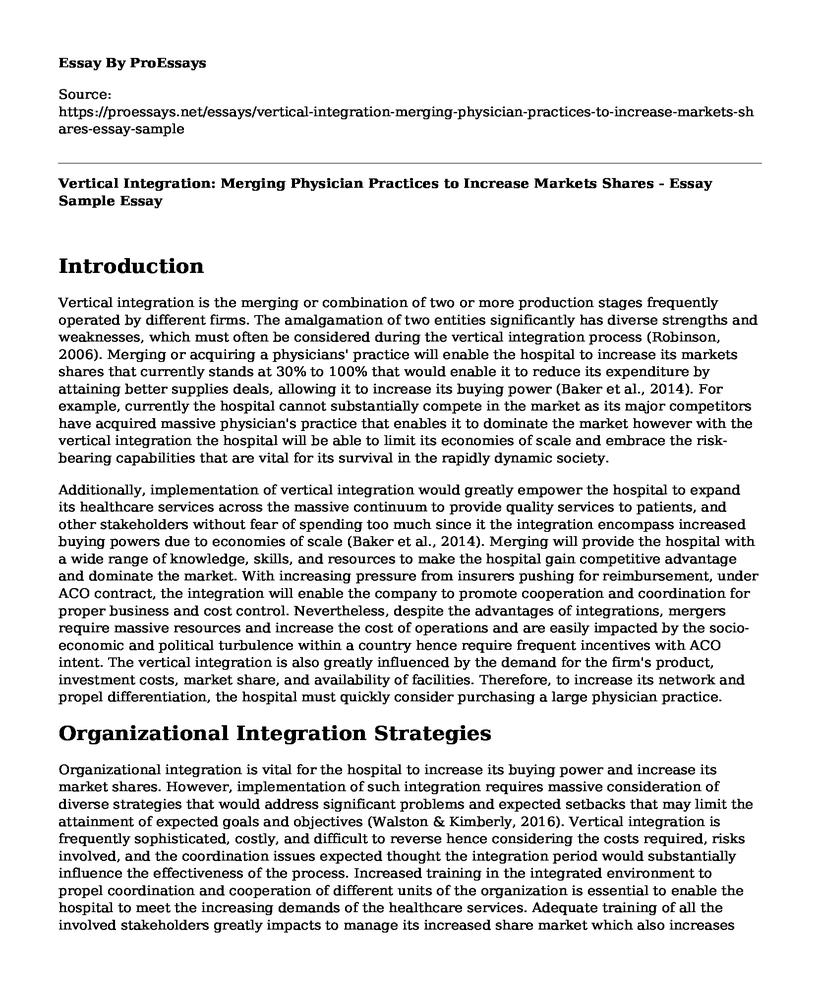Introduction
Vertical integration is the merging or combination of two or more production stages frequently operated by different firms. The amalgamation of two entities significantly has diverse strengths and weaknesses, which must often be considered during the vertical integration process (Robinson, 2006). Merging or acquiring a physicians' practice will enable the hospital to increase its markets shares that currently stands at 30% to 100% that would enable it to reduce its expenditure by attaining better supplies deals, allowing it to increase its buying power (Baker et al., 2014). For example, currently the hospital cannot substantially compete in the market as its major competitors have acquired massive physician's practice that enables it to dominate the market however with the vertical integration the hospital will be able to limit its economies of scale and embrace the risk-bearing capabilities that are vital for its survival in the rapidly dynamic society.
Additionally, implementation of vertical integration would greatly empower the hospital to expand its healthcare services across the massive continuum to provide quality services to patients, and other stakeholders without fear of spending too much since it the integration encompass increased buying powers due to economies of scale (Baker et al., 2014). Merging will provide the hospital with a wide range of knowledge, skills, and resources to make the hospital gain competitive advantage and dominate the market. With increasing pressure from insurers pushing for reimbursement, under ACO contract, the integration will enable the company to promote cooperation and coordination for proper business and cost control. Nevertheless, despite the advantages of integrations, mergers require massive resources and increase the cost of operations and are easily impacted by the socio-economic and political turbulence within a country hence require frequent incentives with ACO intent. The vertical integration is also greatly influenced by the demand for the firm's product, investment costs, market share, and availability of facilities. Therefore, to increase its network and propel differentiation, the hospital must quickly consider purchasing a large physician practice.
Organizational Integration Strategies
Organizational integration is vital for the hospital to increase its buying power and increase its market shares. However, implementation of such integration requires massive consideration of diverse strategies that would address significant problems and expected setbacks that may limit the attainment of expected goals and objectives (Walston & Kimberly, 2016). Vertical integration is frequently sophisticated, costly, and difficult to reverse hence considering the costs required, risks involved, and the coordination issues expected thought the integration period would substantially influence the effectiveness of the process. Increased training in the integrated environment to propel coordination and cooperation of different units of the organization is essential to enable the hospital to meet the increasing demands of the healthcare services. Adequate training of all the involved stakeholders greatly impacts to manage its increased share market which also increases the organizational operation field as it must expand not only to offer more quality services but to boost its productivity and profitability (Walston & Kimberly, 2016). The increased market share gives the organization to attract many consumers due to quality services offered. However, the operational costs also increase propelling organizational risk, which may be difficult or unbearable to manage. The organizational integration requires prompt analysis and evaluation of the market and risks involved in the vertical integration process. Therefore, considering the markets' demand for the firm's product, investment costs, market share and availability of facilities fundamentally propels the success of the hospital physician's practice amalgamation.
References
Baker, L. C., Bundorf, M. K., & Kessler, D. P. (2014). Vertical integration: hospital ownership of physician practices is associated with higher prices and spending. Health Affairs, 33(5), 756-763. https://www.healthaffairs.org/doi/full/10.1377/hlthaff.2013.1279
Robinson, J. C., & Casalino, L. P. (2006). Vertical integration and organizational networks in health care. Health Affairs, 15(1), 7-22. https://www.healthaffairs.org/doi/full/10.1377/hlthaff.15.1.7
Walston, S. L., & Kimberly, J. R. (2016). Integration and. Integrated Health Care Delivery: Theory, Practice, Evaluation, and Prognosis, 21(1), 72. https://books.google.co.ke/books?hl=en&lr=&id=E9bFfb5yp80C&oi=fnd&pg=PA72&dq=vertical+integration+in+healthcare&ots=G6HE_qVPac&sig=Jn8kZt1TiladJCXERLfuK-S5Irc&redir_esc=y#v=onepage&q=vertical%20integration%20in%20healthcare&f=false
Cite this page
Vertical Integration: Merging Physician Practices to Increase Markets Shares - Essay Sample. (2023, Jan 16). Retrieved from https://proessays.net/essays/vertical-integration-merging-physician-practices-to-increase-markets-shares-essay-sample
If you are the original author of this essay and no longer wish to have it published on the ProEssays website, please click below to request its removal:
- The Marketing Mix of Turkey
- Nursing Paper Sample: Nursing Care Models
- Application for a Spine Surgery Fellowship
- Breastfeeding Support, Protection and Promotion Policy Essay
- Quality Measures: Tools for Quality Health Care Services - Essay Sample
- Essay Example on 29% Profit Increase: My Journey in Retail Marketing
- Free Report Sample on Drug Prescription Prices: Investigating the Increase in Costs







